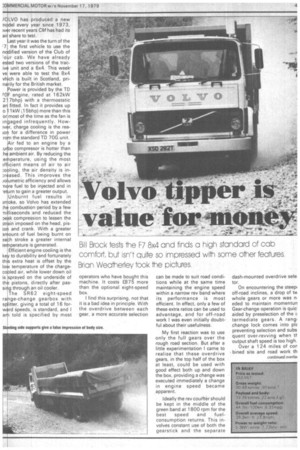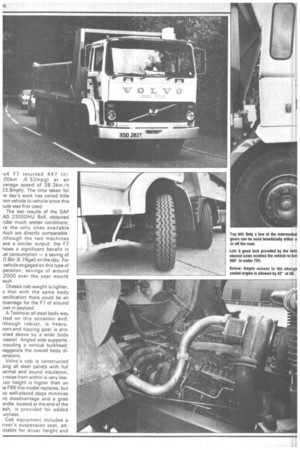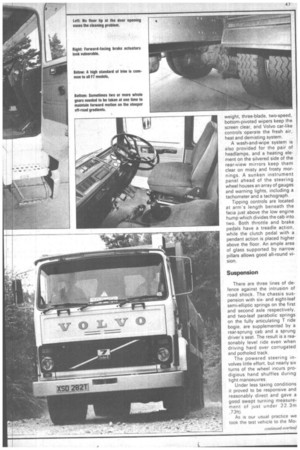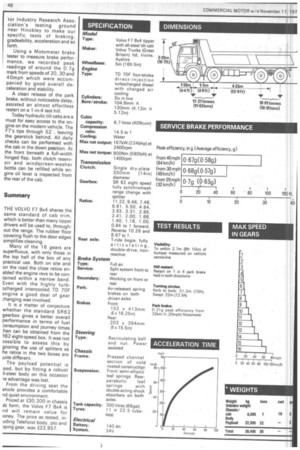LVO has produced a new del every year since 1973, r recent years CM has had its share to test.
Page 47

Page 48

Page 49

Page 50

If you've noticed an error in this article please click here to report it so we can fix it.
st year it was the turn of the the first vehicle to use the dified version of the Club of r cab. We have already ed two versions of the tracunit and a 6x4. This week.
ye were able to test the 8)(4
✓ ich is built in Scotland, pri n rily for the British market. Power is provided by the TD F engine, rated at 162kW 2 7bhp) with a thermostatic a fitted. In fact it provides up o lkW .,15bhp) more than this or most of the time as the fan is :n aged infrequently. Flown/ r, charge cooling is the rea o for a difference in power ro the standard TD 70G unit.
Air fed to an engine by a u •o compressor is hotter than h ambient air. By reducing the
e perature, using the most :f icient means of air to air o.ling, the air density is inased. This improves the umetric efficiency and allows ns re fuel to be injected and in rn to gain a greater output. Unburnt fuel results in 3 oke, so Volvo has extended combustion period by a few milliseconds and reduced the De k compression to lessen the 3t in imposed on the head, pisto and crank. With a greater 3 amt of fuel being burnt on aa h stroke a greater internal te perature is generated.
Efficient engine cooling is the ke to durability and fortunately th s extra heat is offset by the lo temperature of the chargeco led air, while lower down oil is sprayed on the underside of th pistons, directly after pass' g through an oil cooler.
The SR62 eight-speed ra ge-change gearbox with s litter, giving a total of 16 forw rd speeds, is standard, and I a told is specified by most )v ai
:7
es iv operators who have bought this machine. It costs £875 more than the optional eight-speed box.
I find this surprising, not that it is a bad idea in principle. With the overdrive between each gear, a more accurate selection can be made to suit road conditions while at the same time maintaining the engine speed within a narrow rev band where its performance is most efficient. In effect, only a few of these extra ratios can be used to advantage, and for off-road work I was even initially doubtful about their usefulness.
My first reaction was to use only the full gears over the rough road section. But after a little experimentation I came to realise that these overdrive gears, in the top half of the box at least, could be used with good effect both up and down the box, providing a change was executed immediately a change in engine speed became apparent.
Ideally the rev couilter should be kept in the middle of the green band at 1800 rpm for the best speed and fuelconsumption returns. This involves constant use of both the gearstick and the separate dash-mounted overdrive sele. tor.
On encountering the steep' off-road inclines, a drop of tm. whole gears or more was ri. eded to maintain nnomentun Gear-change operation is quic aided by preselection of the ii termediate gears. A rang. change lock comes into plz preventing selection and subs quent over-revving when tt output shaft speed is too high.
Over a 124 miles of con bined site and road work th
;x4 F7 returned 447 lit/ 00km ;6.32mpg) at an verage speed of 38.3km / h 23.8mph). The time taken for le day's work has varied little -om vehicle to vehicle since this )ute was first used.
The test results of the OAF AD 2305DHU 8x4, obtained nder much wetter conditions, re the only ones available thich are directly comparable. .l-though the two machines ave a similar output, the F7 hows a significant benefit in „lel consumption — a saving of 0.8Iit ;6.78gal) on the day. For vehicle engaged on this type of peration, savings of around 2000 over the year would )sult.
Chassis cab weight is lighter, D that with the same body Decification there could be an dvantage for the F7 of around cwt in payload.
A Telehoist all steel body was tied on this occasion and, lthough robust, is heavy. ront-end tipping gear is pro:cted above by a wide body -ossrail. Angled side supports, lrouding a vertical bulkhead, Kaggerate the overall body ditensions.
Volvo's cab is constructed sing all steel panels with full termal and sound insulation, ) noise from within is very low. oor height is higher than on le F86 this model replaces, but vo well-placed steps minimise us disadvantage and a grab andle, located at the end of the ash, is provided for added jrchase.
Cab equipment includes a river's suspension seat, adstable for driver height and weight, three-blade, two-speed, bottom-pivoted wipers keep the screen clear, and Volvo car-like controls operate the fresh air, heat and demisting system.
A wash-and-wipe system is also provided for the pair of headlamps, and a heating element on the silvered side of the rear-view mirrors keep them clear on misty and frosty mornings. A sunken instrument panel ahead of the steering wheel houses an array of gauges and warning lights, including a tachometer and a tachograph.
Tipping controls are located at arm's length beneath the facia just above the low engine hump which divides the cab into two. Both throttle and brake pedals have a treadle action, while the clutch pedal with a pendant action is placed higher above the floor. An ample area of glass supported by narrow pillars allows good all-round vision.
Suspension
There are three lines of defence against the intrusion of road shock. The chassis suspension with sixand eight-leaf semi-elliptic springs on the first and second axle respectively, and two-leaf parabolic springs on the fully articulating T ride bogie, are supplemented by a rear-sprung cab and a sprung driver's seat. The result is a reasonably level ride even when driving hard over corrugated and potholed track.
The powered steering involves little effort, but nearly six turns of the wheel incurs prodigious hand shuffles during tight manoeuvres.
Under less taxing conditions it proved to be responsive and reasonably direct and gave a good swept turning measurement of just under 22.3m 73ft).
As is our usual practice we took the test vehicle to the Nilo tor Industry Research Association's testing ground near Hinckley to make our specific tests of braking, gradeability, acceleration and so forth.
Using a Motometer brake tester to measure brake performance, we recorded peak readings of around the 0.7g mark from speeds of 20, 30 and 40mph which were accompanied by good overall deceleration and stability.
A dean release of the park brake, without noticeable delay, assisted an almost effortless restart on a 1-in-4 test hill.
Today hydraulic tilt cabs are a must for easy access to the engine on the modern vehicle. The F7's tips through 52 , leaving the gearstick behind. All daily checks can be performed with the cab in the down position. At the front beneath a full-width hinged flap, both clutch reservoir and windscreen-washer bottle can be refilled while engine oil level is inspected from the rear of the cab.
Summary
THE VOLVO F7 8x4 shares the same standard of cab trim, which is better than many tipper drivers will be used to, throughout the range. The rubber floor covering flush to the door edges simplifies cleaning.
Many of the 1 6 gears are superfluous, with only those in the top half of the box of any practical use. Both on site and on the road the close ratios enabled the engine revs to be contained within a narrow band. Even with the highly turbocharged intercooled TD 70F engine a good deal of gear ;:hanging was involved.
It is a matter of conjecture whether the standard SR 62 gearbox gives a better overall performance in terms of fuel :onsumption and journey times :han can be obtained from the R62 eight-speed box. It was not )ossible to assess this by gnoring the use of splitters as he ratios in the two boxes are iuite different.
The payload potential is ood, but by fitting a robust II-steef body on this occasion -)e advantage was lost.
From the driving seat the ehicle provides a comfortable nd quiet environment.
Priced at £30,200 in chassis oh form, the Volvo F7 8x4 is nd will remain value for ioney. The price as tested, inuding Telehoist body, pto and ving gear, was £33,957.




























































































































































